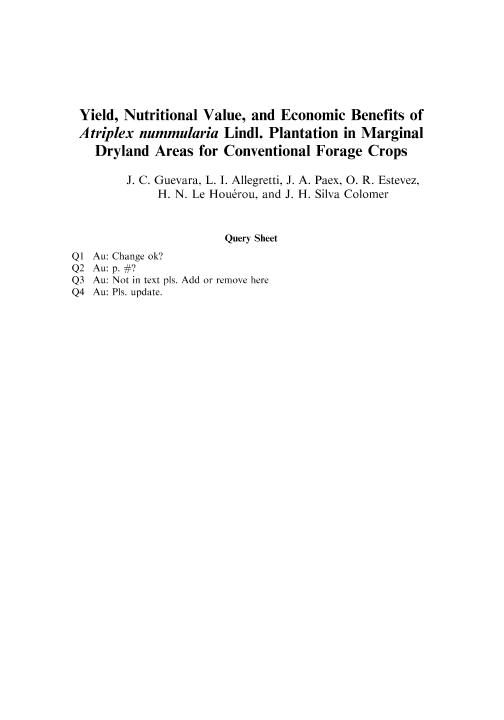Mostrar el registro sencillo del ítem
dc.contributor.author
Guevara, Juan Carlos

dc.contributor.author
Allegretti, Liliana Inés

dc.contributor.author
Paez, J. A.
dc.contributor.author
Estevez, Oscar Roberto

dc.contributor.author
Le Houérou, H. N.
dc.contributor.author
Silva Colomer, Jorge Horacio

dc.date.available
2020-03-19T18:59:07Z
dc.date.issued
2005-10
dc.identifier.citation
Guevara, Juan Carlos; Allegretti, Liliana Inés; Paez, J. A.; Estevez, Oscar Roberto; Le Houérou, H. N.; et al.; Yield, nutritional value, and economic benefits of Atriplex nummularia Lindl. plantation in marginal dryland areas for conventional forage crops; Taylor & Francis; Arid Land Research And Management; 19; 4; 10-2005; 327-340
dc.identifier.issn
1532-4982
dc.identifier.uri
http://hdl.handle.net/11336/100333
dc.description.abstract
This study assessed: (a) the total aerial and browse biomass of Atriplex nummularia Lindl. (saltbush) on ungrazed 9, 21, and 33-month old shrubs; (b) some relevant nutritional parameters for browse: and (c) the economics benefits of saltbush plantations in terms of cost ratios of energy and protein of saltbush vs. alfalfa, Medicago sativa L., hay. Three-month old nursery-grown speedlings were hand transplanted into a furrow bottom at a spacing of 1 x 2 m in an area with shallow (1-1.1 m deep) and moderately saline (4.6 dS m -1) water table. Seven rows of about 110 plants each were established. Linear regression equations of shrub volume on total and browse biomass were estimated. Nutritional parameters were determined for 33-month old shrubs. To estimate the cost of saltbush plantation, the following scenarios were considered: (a) poorly and adequately managed plantations (10- and 30-year life-span, respectively), (b) saltbush browse yields from 1.0 to 6.5 Mg D M ha-1 year-1, and (c) two management systems (cut-and-carry for pen feeding and direct browsing). For alfalfa crop, cultivated under irrigation, the life-span was four years and the yield was 10 Mg D M ha -1 year-1 from year two onward. Costs through the life-span of the two crops were discounted at present value using a 12.0% discount rate. Browse biomass was about 0.4, 0.8, and 1.4 kg D M shrub -1 for 9-, 21-, and 33-month old shrubs, respectively, or 6.5 Mg D M ha-1 year-1 for the oldest saltbush plants, corresponding with the surviving 4,665 shrubs ha-1. Mean values of nutritional parameters were: organic matter, 74.7%; in vitro organic matter digestibility, 47.0%; ash, 25.3%; crude protein, 13.6%; Na, 5.6%; and Cl, 7.7%. Saltbush proved to be a highly productive species in areas that are marginal or unsuited for conventional crops such as alfalfa. The cost ratio saltbush/alfalfa hay for metabolizable energy and crude protein was lower than one for all the scenarios related to life-span and management systems of saltbush when saltbush yield was higher than 3.0 Mg D M ha-1 yr-1. The overall mean cost ratio saltbush/alfalfa hay for crude protein and metabolizable energy for all the scenarios was 0.22, considerably lower than that considered in our hypothesis.
dc.format
application/pdf
dc.language.iso
eng
dc.publisher
Taylor & Francis

dc.rights
info:eu-repo/semantics/openAccess
dc.rights.uri
https://creativecommons.org/licenses/by-nc-sa/2.5/ar/
dc.subject
ALFALFA HAY
dc.subject
BROWSE BIOMASS
dc.subject
CRUDE PROTEIN
dc.subject
ENERGY
dc.subject
ESTABLISHMENT COST
dc.subject
MAINTENANCE COST
dc.subject
METABOLIZABLE
dc.subject
SALTBUSH
dc.subject
TOTAL BIOMASS
dc.subject.classification
Ganadería

dc.subject.classification
Producción Animal y Lechería

dc.subject.classification
CIENCIAS AGRÍCOLAS

dc.title
Yield, nutritional value, and economic benefits of Atriplex nummularia Lindl. plantation in marginal dryland areas for conventional forage crops
dc.type
info:eu-repo/semantics/article
dc.type
info:ar-repo/semantics/artículo
dc.type
info:eu-repo/semantics/publishedVersion
dc.date.updated
2020-03-19T14:33:17Z
dc.journal.volume
19
dc.journal.number
4
dc.journal.pagination
327-340
dc.journal.pais
Reino Unido

dc.journal.ciudad
Londres
dc.description.fil
Fil: Guevara, Juan Carlos. Consejo Nacional de Investigaciones Científicas y Técnicas. Centro Científico Tecnológico Conicet - Mendoza. Instituto Argentino de Investigaciones de las Zonas Áridas. Provincia de Mendoza. Instituto Argentino de Investigaciones de las Zonas Áridas. Universidad Nacional de Cuyo. Instituto Argentino de Investigaciones de las Zonas Áridas; Argentina
dc.description.fil
Fil: Allegretti, Liliana Inés. Consejo Nacional de Investigaciones Científicas y Técnicas. Centro Científico Tecnológico Conicet - Mendoza. Instituto Argentino de Investigaciones de las Zonas Áridas. Provincia de Mendoza. Instituto Argentino de Investigaciones de las Zonas Áridas. Universidad Nacional de Cuyo. Instituto Argentino de Investigaciones de las Zonas Áridas; Argentina
dc.description.fil
Fil: Paez, J. A.. Consejo Nacional de Investigaciones Científicas y Técnicas. Centro Científico Tecnológico Conicet - Mendoza. Instituto Argentino de Investigaciones de las Zonas Áridas. Provincia de Mendoza. Instituto Argentino de Investigaciones de las Zonas Áridas. Universidad Nacional de Cuyo. Instituto Argentino de Investigaciones de las Zonas Áridas; Argentina
dc.description.fil
Fil: Estevez, Oscar Roberto. Consejo Nacional de Investigaciones Científicas y Técnicas. Centro Científico Tecnológico Conicet - Mendoza. Instituto Argentino de Investigaciones de las Zonas Áridas. Provincia de Mendoza. Instituto Argentino de Investigaciones de las Zonas Áridas. Universidad Nacional de Cuyo. Instituto Argentino de Investigaciones de las Zonas Áridas; Argentina
dc.description.fil
Fil: Le Houérou, H. N.. Consejo Nacional de Investigaciones Científicas y Técnicas. Centro Científico Tecnológico Conicet - Mendoza. Instituto Argentino de Investigaciones de las Zonas Áridas. Provincia de Mendoza. Instituto Argentino de Investigaciones de las Zonas Áridas. Universidad Nacional de Cuyo. Instituto Argentino de Investigaciones de las Zonas Áridas; Argentina
dc.description.fil
Fil: Silva Colomer, Jorge Horacio. Consejo Nacional de Investigaciones Científicas y Técnicas. Centro Científico Tecnológico Conicet - Mendoza. Instituto Argentino de Investigaciones de las Zonas Áridas. Provincia de Mendoza. Instituto Argentino de Investigaciones de las Zonas Áridas. Universidad Nacional de Cuyo. Instituto Argentino de Investigaciones de las Zonas Áridas; Argentina
dc.journal.title
Arid Land Research And Management

dc.relation.alternativeid
info:eu-repo/semantics/altIdentifier/doi/http://dx.doi.org/10.1080/15324980500299672
dc.relation.alternativeid
info:eu-repo/semantics/altIdentifier/url/https://www.tandfonline.com/doi/abs/10.1080/15324980500299672
Archivos asociados
